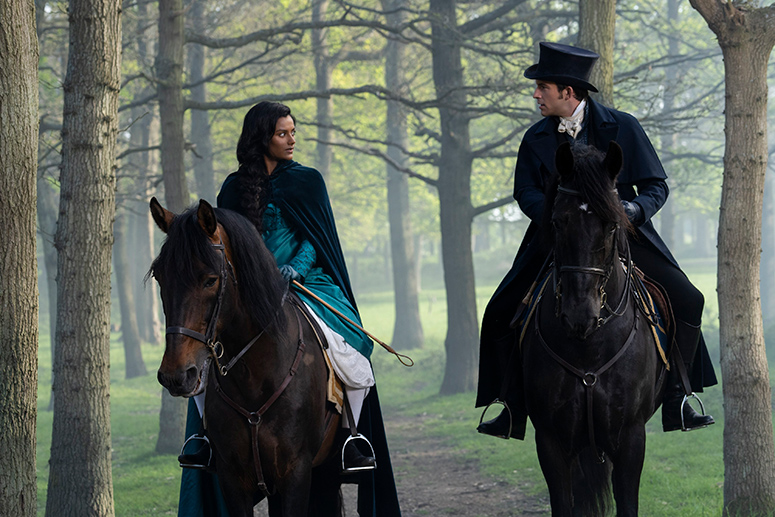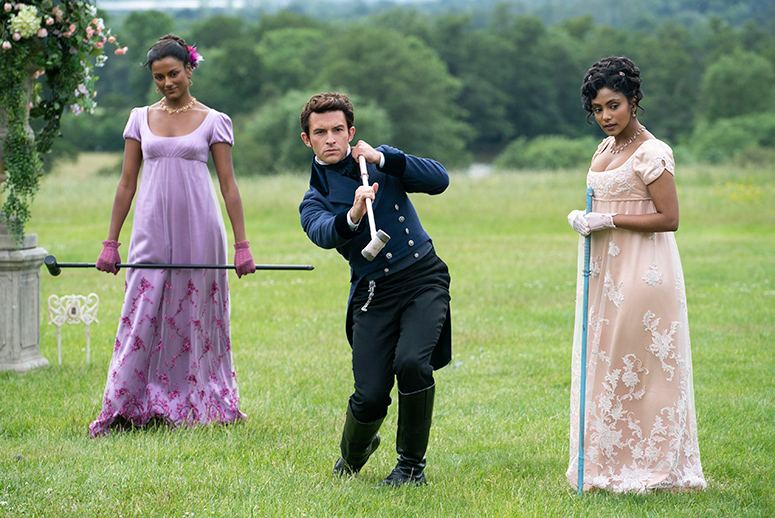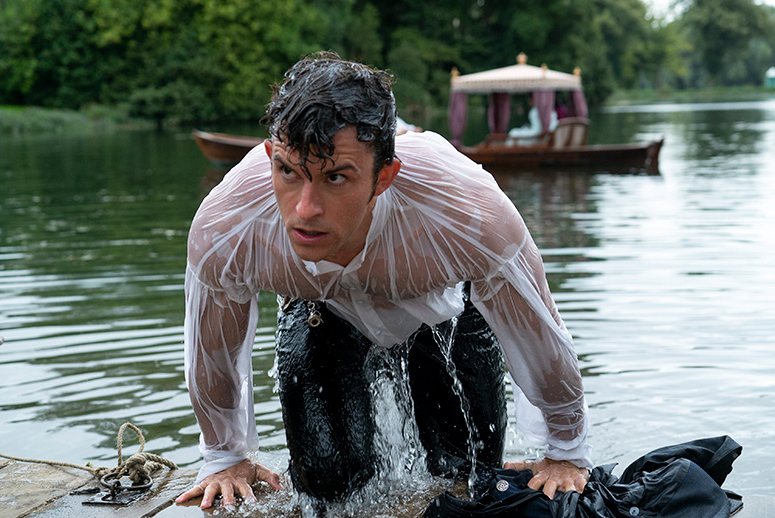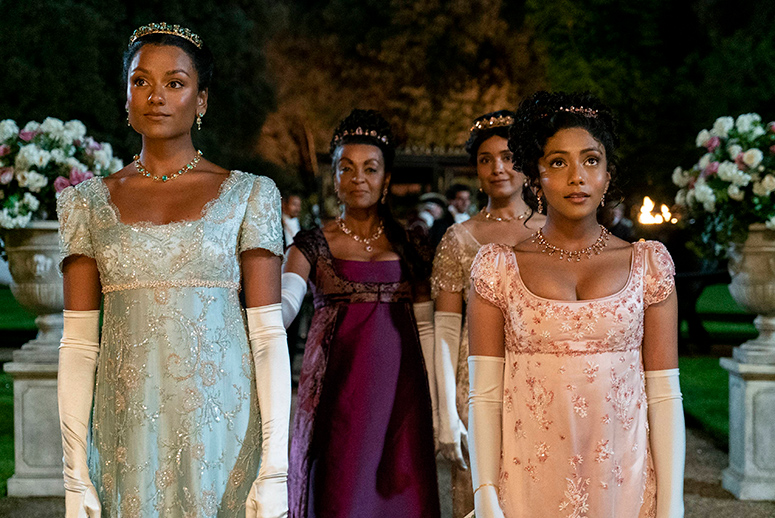'Bridgerton' stars on filming sexy scenes, romantic chemistry and female empowerment
“Love's about finding the one person who makes your heart complete. Who makes you a better person than you ever dreamed you could be.”
Sounds simple? It never is in Bridgerton, the Netflix series that became a runaway hit for its deliciously gossipy portrayal of Regency-era England, complete with a Queen who names her “diamond” debutante each season, and the romantic—often erotic—hijinks that ensue among the diamond, her suitors, and other aristos in the high-society “ton.”
What could have been just another period bodice-ripper set itself apart with its color-blind (the preferred term is “conscious”) casting and its vision of an inclusive world where race is a non-issue and all colors coexist in a well-integrated society.
Bridgerton Season 2 is based on Julia Quinn’s second book, The Viscount Who Loved Me, and focuses on Anthony Bridgerton, the eldest son, and his dutiful hunt for the perfect wife. On the surface that would seem to be Edwina Sharma, whom Queen Charlotte names as her diamond, but Anthony is smitten by a mysterious woman he meets horseback riding in the park, who turns out to be Edwina’s older sister.

We sat down for a roundtable Zoom interview with the three leads who form this love triangle: Jonathan Bailey (Anthony Bridgerton); Simone Ashley (Kate Sharma) and Charithra Chandran (Edwina Sharma). Here are excerpts:
On creating the sizzling chemistry between the romantic leads
SIMONE ASHLEY: It was so effortless, and that's down to brilliant casting, and also brilliant material to kind of lift off the page… and great actors who kind of are on the same wavelength and share the same enthusiasm to bring the story to life.
CHARITHRA CHANDRAN: And we're so lucky because there is so much to the show to just lift us up: beautiful costumes, a beautiful set and the surroundings are so gorgeous. And obviously, the music is great. So, you know, we were really lucky to find that we had a natural chemistry and then all of these additional things to just kind of lift us up.
JONATHAN BAILEY: The innate chemistry in the show is the chemistry between creative departments, including the acting department. But you know, me and Charithra basically come from the same place—we went to the boy and girl equivalency school—so we sort of knew each other. And then Simone and I met in a “chemistry test” (a casting term for seeing if actors click together) and the thing about Kate and Anthony is that the characters are so complex and rich, and it's a very different story. So through that, the love of our characters, and also the excitement of telling a story, we obviously immediately clicked and bonded.

On how they film the sexy scenes
SIMONE: There will always be an intimacy coordinator now to put a physical boundary in place, like a safety object. So that when the two actors are acting and simulating a sex scene, there’s a pillow there for safety and comfort.
JONATHAN: You have basically the rule of three. You have three barriers: you have two personal barriers and then you have one in the middle. And it just means that everyone feels safe and it's amazing to be that resourceful with the things you use, because it turns into something which is, and should be, pragmatic, and therefore doesn't make anything awkward. It's basically a physical challenge, you know, like doing a stunt.
SIMONE: Yeah, it’s like choreographing a scene.
JONATHAN: It's so important when you're telling a romance story to get the intimacy completely right. And especially on a slow burn; you don't want to have a slow burn and then it comes together and you don't quite buy that physical connection.

On their character arcs
SIMONE: I love that we see Kate kind of surrender to the idea of letting someone in. I think she spent a lot of her life putting a lot of pressure on herself to put her family first and that comes from a place of love and is quite an endearing value, I would say, and it's a selfless act. But it's nice to see someone in that position kind of do the scary thing, to kind of let go and find her own path and her own voice and go after her own heart, in a way.
JONATHAN: For me, at the heart of the show, obviously, are these incredible women, and the matriarchs make the show for me, and I think much of Kate and Anthony's arc depends on these amazing scenes with their mothers, and their stepmothers.
CHARITHRA: Edwina’s arc is one of coming of age. She really starts the season as this young girl, perhaps willing to submit and hand over all of her responsibility to her poor sister to look after her. And then by the end, she becomes a young woman ready to own herself.

On their favorite scenes
SIMONE: Ah, good question! I really enjoyed the races (hunting scenes), you know, it was all of us together.
JONATHAN: I really enjoyed the scenes with Ruth Gemmell (who plays his mother, Lady Violet Bridgerton) in series one and so much of Anthony's complex sort of existence is so symbiotic and linked with his mother's experience as well. So that was all brilliant, but you know, the strong female generation above our characters is what makes the show, and so any scenes with them were really thrilling.
CHARITHRA: I loved any family scenes. The heart of Bridgerton is family, so when it's the Sharmas and the Bridgertons gathering and discussing the ton and strategies and whatnot, those were really fun.

On feminism and female empowerment
CHARITHRA: I will say that Daphne in Season 1 is a really empowering character. Season 1 is also incredibly feminist because it's all about Daphne's pleasure, Daphne's exploration. So I think Season 2 is a continuation of what was already so strong and important in Season 1, and the addition of two wonderful feminist characters, especially Kate Sharma.
SIMONE: I think they've just got great values, and they're really smart. And for me, that’s kind of it. The conversations between Kate and Edwina—I don't think they're very superficial. It goes much more beneath that.
JONATHAN: Feminism is explored throughout in all its different guises. And it’s not just the female characters; you have the amazing male ally-ship in Benedict's and Eloise’s relationship, and that sort of elevation is important and a study of what feminism really is.
CHARITHRA: Historically, as we're seeing second-wave feminism in the ’60s, women were kind of encouraged to reject traditionally feminine traits and take on more masculine traits. But actually, that's sort of an anti-feminist in a way, right, because you're rejecting traditional feminine traits. And what the show shows is that feminism, strength, female empowerment can be embodied in any personality and character type—ones that are outwardly confident and independent, but also ones that are more gentle and sweet-natured. It's not to do with outward traits, but our inner strength. And I think every female character represents that in different ways, including Daphne in Season 1.
As Bridgerton’s gossip writer Lady Whistledown might say, “Well, dear readers, you’ll just have to tune in to Season 2 to find out who wins Anthony Bridgerton’s heart. Is it the gentle, sweet-natured Edwina or the independent, headstrong Miss Kate? Only the most steadfast viewers will know.”


